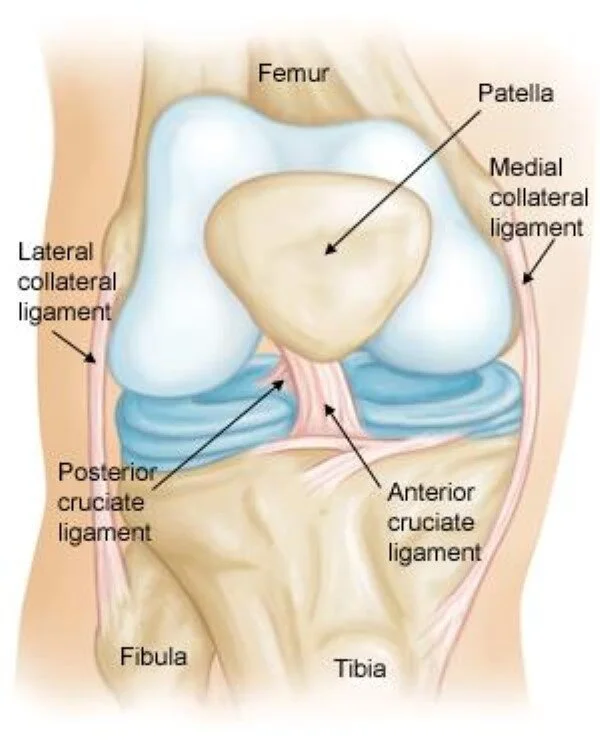Anterior Cruciate Ligament (ACL) Injuries
WHAT IS THE ACL?
The knee joint is held together by four ligaments. There is a ligament on each side of the knee (the collateral ligaments) and two ligaments deep inside the knee. The two ligaments inside the knee cross each other, and are called the anterior cruciate ligament (ACL) and the posterior cruciate ligament (PCL). The ACL joins the tibia (leg bone) to the femur (thigh bone). It prevents excessive sliding motion from occuring in the knee joint. This function is most important during twisting and pivoting activities, particularly when running or playing sport. A ruptured ACL can result in a feeling of instability and sometimes pain in your knee when trying to perform these activities.
HOW IS THE ACL INJURED?
The ACL is most commonly injured during sporting activity. It can be damaged by a direct blow to the knee, such as in a rugby tackle. The other common mechanism of injury is a twisting motion such as landing awkwardly from a jump, or twisting with your foot standing on the ground such as when playing soccer. High risk sports for an ACL injury include rugby, netball, soccer and basketball. Injuries can also happen at work, or in car or motorbike accidents.
WHAT ARE THE SYMPTOMS OF AN ACL TEAR?
A torn ACL results in immediate pain and rapid swelling of the knee joint. Most people will be unable to walk without assistance for several days. It is common to hear or feel a ‘pop’ at the time the injury occurs. Once the swelling has settled, the most common symptom is a sensation of the knee giving way or feeling unstable when turning or changing direction. In the early stages after your injury, the feeling of giving way or buckling of your knee when walking may not be due to the torn ACL, and may actually be caused by weakness and giving way of the quadriceps muscles.
HOW IS AN ACL TEAR DIAGNOSED?
A torn ACL can be diagnosed based on your symptoms and clinical examination by an appropriately trained specialist. The surgeon or specialist will test to see if there is an increased amount of front-to-back movement within your knee. X-rays will not show the ligaments, but are recommended to look for fractures and damage to the bones of the knee which may have occured during your injury. The best way to confirm the diagnosis of an ACL tear is with an MRI scan. This scan will also identify any damage to the cartilage and other ligaments within the knee; this may affect the treatment recommended for you.
WHO NEEDS SURGERY?
The best treatment for an ACL tear depends on each patient’s age, activity level, and the presence or absence of injury to other structures within the knee.
Having a working ACL is not necessary for low stress activities such as walking, swimming, cycling or even straight line running. If your lifestyle only involves these kinds of activities it may be reasonable to rehabilitate your knee, strengthen your quadriceps muscles, and avoid having surgery. The ACL is an important stabiliser of your knee when performing pivoting or twisting activities, such as those required during most sports. If you intend to return to sporting activities or heavy manual work, then reconstruction is usually recommended to improve stability and avoid further damage to the cartilage in your knee caused by episodes of instability.
If you have evidence of damage to other structures within your knee, in particular a torn meniscus, then surgery may be recommended. The meniscus is the C-shaped disc of cartilage which sits inside the knee joint and acts as a natural shock-absorber; it protects the rest of your knee from damage during normal activity. If your meniscus is already torn, ongoing instability due to a ruptured ACL will lead to further damage and may eventually lead to arthritis. Any attempts to repair the meniscus without fixing the ACL are unlikely to be succesful as the meniscus needs a stable environment in order to heal.
WHAT IS THE NON-SURGICAL MANAGEMENT OF A TORN ACL?
If your ACL injury is managed without surgery, the main focus of rehabilitation is regaining knee motion and strength of the quadriceps muscles. Swelling is allowed to settle after injury, and icing may help with this. After two weeks you should work on regaining knee bending and straightening. A physiotherapist referral may be needed at this stage. Once you have regained movement you will need to work on restoring strength. This is best done by regular use of an exercycle/stationary bike, and gym-based exercises such as squats, leg raises and leg press weights. It will take at least three months to rebuild your muscle strength. If you have ongoing instability after this time, ligament reconstruction may be indicated.
What is the surgical management of a torn ACL?
The operation to fix a torn ACL is called an ACL reconstruction. Please click this link to learn more about ACL reconstruction.

